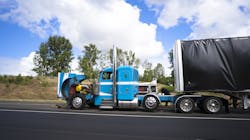Roadside tire service is inevitable in trucking, but technician fatalities and injuries should not be. Our industry has an obligation to increase efforts to protect the people who risk their lives to service vehicles on the side of a road or highway.
Commercial tire dealers and truck stops provide technicians with detailed training to minimize the chances of being struck by a passing vehicle. They are instructed on where to position the service truck and how to set up reflective devices with other warnings to alert traffic that it’s an active work zone. A few recent accidents proved that following those guidelines will protect the technician. In those cases, passing vehicles caused accidents on the shoulder, and the technicians walked away without a scratch.
See also: Wheel-end monitors: Tech that helps avoid costly ‘thermal events’
One of the most significant components of that training is site assessment. Everything from the position of the tire(s) in need of service to the condition of the ground surface must be evaluated before any work can begin. If the situation is not safe, then the vehicle must be moved. I’ve personally investigated accidents where technicians were fatally injured working on the side of a highway because the vehicle wasn’t moved. In most instances, the technicians chose to accept the risks of working on a vehicle that was in an unsafe position. There is a concerted effort by commercial tire dealers and truck stops to provide additional training in this area to prevent future tragedies.
At a recent industry meeting, I gave a presentation about road service safety and the importance of moving the vehicle when the work area is not safe. During the discussion period that followed, it became evident that far too many fleets are resistant to moving the vehicle because they don’t want to replace more than the tires. What I heard was the value of the wheel is greater than the value of the life of the person who may be more or less forced to work in an incredibly dangerous position. Explain that to a jury or the relatives of the deceased—or both.
See also: Saving with tire section repairs
Money is tight, costs are rising, and the hits keep coming. I get it. However, fuel and tires are two areas of operation for fleet operators that cannot be avoided. People are going to have to get used to higher prices as a direct effect of skyrocketing diesel fuel. And tire surcharges may not be far behind.
Every fleet wants to control its tire costs, and adding a few more wheels to the roadside service budget is not preferable. While it would be fantastic if drivers were instructed to consider the safety of the roadside technician when they pull over, it’s not high on the priority list of things that fleets would like drivers to do on a regular basis.
However, it’s at the top of the priority list for a growing number of commercial tire dealers and truck stop operators. They are not going to accept the unnecessary risks that accompany hazardous roadside service conditions. If their technicians say the vehicle is in an unsafe position, then either the vehicle is moved, or they pack up their warning devices and head back to the shop. These companies will not risk the lives of their technicians for a few hundred dollars.
See also: When irregular tire wear talks, fleets need to listenThe goal is for every reputable commercial tire service provider to support their technicians and agree to turn down the business when the work site is not safe. Some are already there and have the backing of ownership to walk away if the risks are too severe. For the fleet, it may result in an extra wheel purchase here and there, but the alternative is waiting for someone else to come back out and potentially agree that the position of the vehicle is unsafe.
Of course, all of this can be avoided if drivers and maintenance personnel are trained to consider all the factors when pulling over to the side of the road for tire service, or they agree to just move the truck when the technician says it’s not safe.
Kevin Rohlwing is the SVP of training for the Tire Industry Association. He has more than 39 years of experience in the tire industry and has created programs to help train more than 180,000 technicians.
About the Author
Kevin Rohlwing
Kevin Rohlwing is the SVP of training for the Tire Industry Association. He has more than 40 years of experience in the tire industry and has created programs to help train more than 180,000 technicians.
